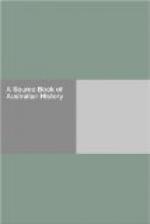Government House, Sydney. Dec. 5, 1859. (Received Feb. 9, 1860.)
My Lord Duke,
I have the honour to acknowledge the receipt of your Grace’s Despatch, No. 11, dated 18th August last, enclosing copies of the warrant establishing Queensland as a colony separate from New South Wales, and appointing Sir George Ferguson Bowen, K.C.M.G., Governor of the same; also of the instructions issued to Sir George Bowen, and of the Order-in-Council empowering him to make laws and to provide for the administration of justice in the said colony.
Sir George Bowen arrived here by the mail steamer on the 15th ult.; he remained with me at Sydney, making arrangements for the establishment of the various departments of his Government, in which I gave him every assistance in my power, and he sailed for Moreton Bay in Her Majesty’s ship “Cordelia” on the 3rd instant.
I enclose copies of the proclamation issued by me notifying the separation of the two colonies. The Proclamation Sir George has taken with him to Brisbane, and by its publication there the fact of its separation will be made known to the inhabitants of Queensland, which will from the date of that Proclamation, that is, 1st December, be in every respect freed from the interference of the Government or Legislature of New South Wales....
I have, etc.,
(Signed) W. Denison.
His Grace the Duke of Newcastle, etc., etc., etc.
COPY OF A DESPATCH FROM GOVERNOR SIR G.F. BOWEN TO HIS GRACE THE DUKE OF NEWCASTLE.
Government House, Brisbane, Queensland.
Jan. 6th, 1860.
(Received March 12, 1860.)
My Lord Duke,
In my Despatch, No. 3, of the 28th November ultimo, I mentioned that extensive districts within the colony of Queensland are well adapted for the growth of the sugar cane among a variety of other produce.
2. Since I wrote the above Despatch, I have seen three specimens of the sugar cane, which have been grown near the town of Maryborough. These specimens, which were finer than any that were shown me at Mauritius, were forwarded to Sir William Macarthur, a gentleman of large property, well-known ability, and great experience in scientific and agricultural pursuits; and who was Commissioner for New South Wales at the Paris Exhibition of 1855. I have received permission to transmit to your Grace the following extract from a letter containing Sir William Macarthur’s opinion of the samples submitted to him:—“I yesterday made several trials of the juice of the sugar cane forwarded by Mr. Aldridge, of Maryborough.
“As I had to extract the juice by pounding the cane in a mortar, I only experimented upon the largest and the smallest of the three forwarded. As they appear to have excited some attention, I may mention that they were quite ripe, of a bright, yellowish-brown colour, with the joints from two to five inches apart, the largest being about ten feet long, not quite eight inches in circumference, and weighing just eighteen pounds. About three feet of the upper end, however, was too short-jointed to yield abundantly, and hardly ripe.




